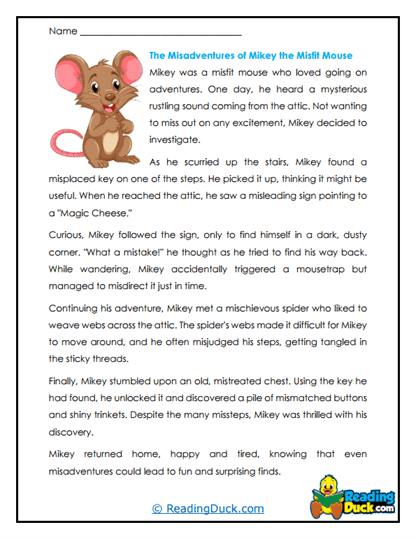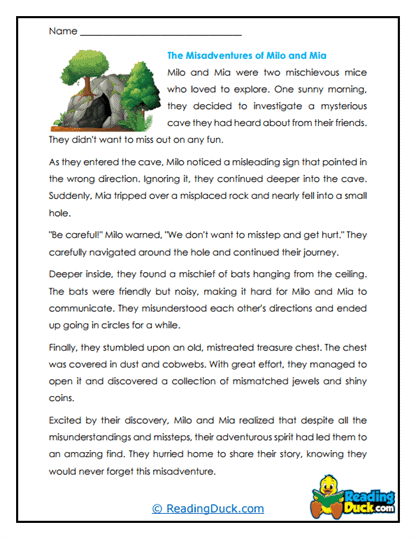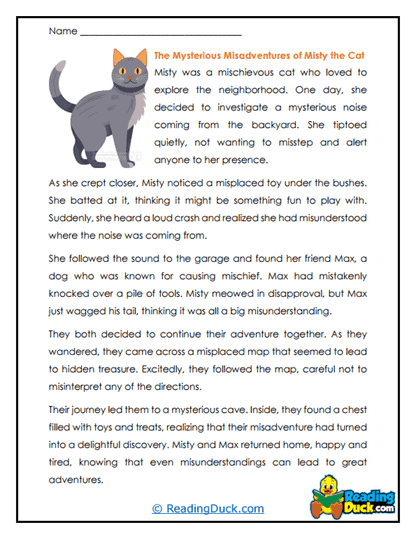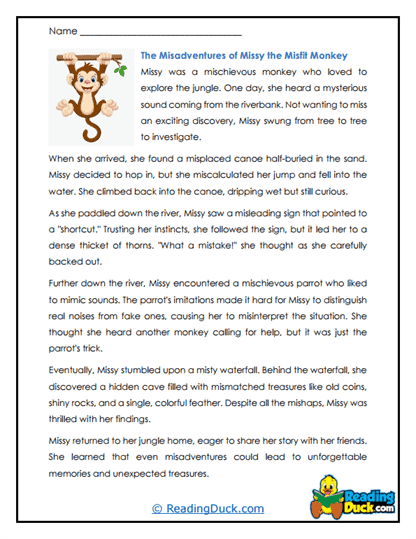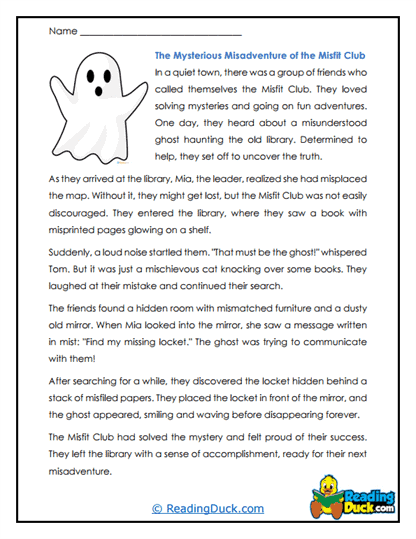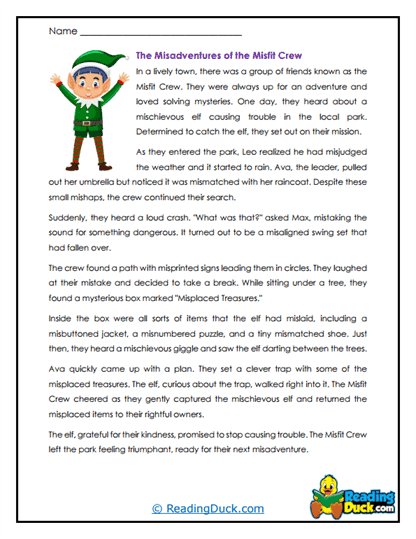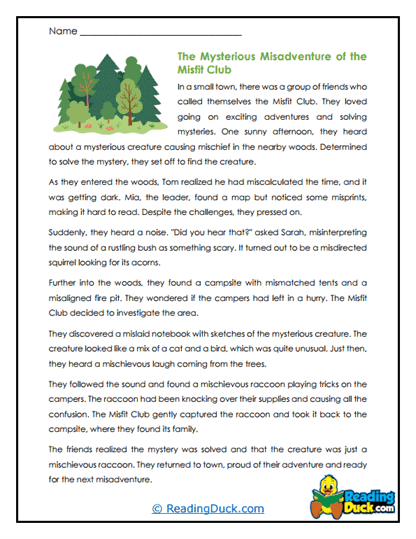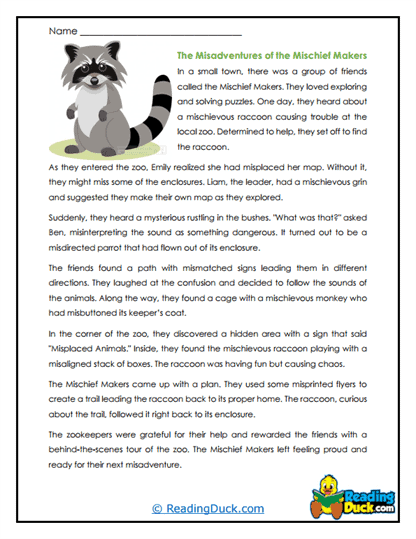Mis- Prefix Reading Passages Worksheets
About Our Mis- Prefix Reading Passages Worksheets
The Mis- Prefix Reading Passages Worksheets are designed to help students deepen their understanding and application of the prefix "mis-" through engaging and targeted reading passages. Each worksheet features a reading passage that highlights words with the prefix "mis-," accompanied by a vibrant, eye-catching picture that helps students visually connect to the context of the passage. These worksheets make learning fun and engaging by connecting vocabulary practice to real-world reading scenarios.
Each worksheet is structured to include multiple-choice comprehension questions to assess how well students understand both the passage and the role the "mis-" prefix plays in modifying word meanings. These questions provide an excellent opportunity for students to practice recognizing the prefix and understanding its impact in context.
The worksheets are provided in easy-to-use PDF format, making them simple to download, view, and print. Each worksheet also includes a downloadable answer key for convenient grading and feedback, which makes them practical and efficient tools for teachers, parents, and tutors alike. Whether used in a classroom, small group, or home setting, these worksheets provide structured support for developing vocabulary and reading comprehension skills.
The Role of Prefixes in Vocabulary Growth and Word Decoding
Prefixes are vital components of language that aid in vocabulary expansion and word decoding. They are affixed to the beginning of root words, modifying their meanings. By learning how prefixes function, students gain a better understanding of how words are formed, giving them the skills to break down unfamiliar words into parts that are easier to understand.
A key part of reading comprehension is the ability to decode new words by recognizing familiar prefixes. Common prefixes like "dis-," "pre-," "un-," and "re-" offer students valuable clues about word meanings. For example, the prefix "dis-" often implies negation or reversal, as seen in "disagree" (to not agree) and "disappear" (to vanish). Similarly, "re-" means "again" or "back," which students encounter in words like "rewrite" (to write again) or "return" (to go back).
Mastering these prefixes helps students decode unfamiliar vocabulary as they read, promoting both fluency and comprehension. With a foundational understanding of how prefixes alter the meanings of base words, students are better equipped to approach complex texts with confidence, reducing their reliance on guessing or external assistance.
A Closer Look at the Mis- Prefix
The prefix "mis-" is a common element in the English language that typically means "wrong" or "badly." It is used to convey incorrectness or errors in action, thought, or judgment. By understanding how the prefix "mis-" alters the meanings of root words, students can easily interpret words that indicate mistakes or misunderstandings.
Here are some common examples of words that use the "mis-" prefix:
- Misunderstand: To fail to understand something correctly.
- Misplace: To put something in the wrong location.
- Mislead: To guide someone in the wrong direction or give incorrect information.
- Mistake: An incorrect action or judgment.
- Misbehave: To act in an inappropriate or wrong manner.
The Mis- Prefix Reading Passages Worksheets provide students with numerous opportunities to encounter and practice using words with the "mis-" prefix in context. Through reading passages that reflect everyday scenarios, students will see how the "mis-" prefix alters word meanings, helping them to solidify their understanding and apply it to other reading and writing tasks. This repeated exposure encourages long-term retention of vocabulary skills and supports the development of strong decoding abilities.
Educational Benefits of the Mis- Prefix Worksheets
The Mis- Prefix Reading Passages Worksheets offer several educational benefits that make them an invaluable resource for vocabulary development. Designed to reinforce the concept of the "mis-" prefix, these worksheets support students in building stronger word recognition skills and expanding their vocabulary in meaningful ways.
Here are the key features and benefits of these worksheets:
- Targeted Reading Practice: Each worksheet features a passage rich with words containing the "mis-" prefix, allowing students to see the prefix in context and apply their knowledge.
- Visual Engagement: Every passage is accompanied by a colorful picture that adds visual context to the text, making the learning experience more dynamic and memorable.
- Comprehension Questions: The multiple-choice questions help assess students’ understanding of both the passage and how the "mis-" prefix changes word meaning.
- Easy-to-Use PDF Format: The worksheets are easily downloadable and printable, providing flexibility for teachers, parents, and tutors in various learning environments.
- Answer Keys for Simple Grading: Each worksheet includes an answer key, making grading and providing feedback quick and straightforward.
These worksheets are designed to enhance students’ understanding of the "mis-" prefix while simultaneously improving their reading comprehension and word analysis skills.
Practical Ways to Use These Worksheets in the Classroom or at Home
The Mis- Prefix Reading Passages Worksheets are highly versatile and can be used in multiple instructional settings. Whether they are integrated into classroom lessons, small group work, or assigned for independent practice at home, these worksheets offer a flexible way to support vocabulary growth.
Here are some effective strategies for using these worksheets:
- Whole-Class Instruction: Teachers can introduce the "mis-" prefix during a vocabulary lesson, followed by a group reading of the passage. Afterward, the class can work through the comprehension questions together, facilitating discussion and reinforcing learning.
- Small Group Activities: Divide students into small groups and have them work on the worksheet together. This approach encourages collaboration and allows students to discuss how the "mis-" prefix affects word meaning.
- Independent Practice: Assign the worksheets for independent work, either during class or as homework, allowing students to practice at their own pace and solidify their understanding of the prefix.
- Supplementary Material: Use the worksheets as a supplement to existing prefix or vocabulary lessons. They can be used to reinforce prior learning or to introduce the concept of the "mis-" prefix in a structured way.
By integrating these worksheets into different instructional methods, educators can provide consistent and focused practice that supports long-term retention of the prefix’s meaning and usage.
How These Worksheets Fit into a Broader Vocabulary Curriculum
The Mis- Prefix Reading Passages Worksheets are an excellent addition to a broader vocabulary-building curriculum. By regularly exposing students to new prefixes and root words, they build a more comprehensive understanding of how words are formed and how their meanings change with the addition of prefixes like "mis-," "pre-," "dis-," and "un-."
When students are consistently introduced to new prefixes in reading passages, they become better at recognizing these patterns across different texts. This practice not only enhances their word decoding skills but also improves their overall reading fluency and comprehension. By working with a variety of prefixes over time, students are able to retain and apply these word-building blocks to new words and contexts, which leads to a more robust and flexible vocabulary.
Integrating the Mis- Prefix Reading Passages Worksheets into a comprehensive vocabulary curriculum helps ensure that students receive structured, repeated practice with prefixes, reinforcing their learning in a way that promotes long-term retention.
Decoding Words with Prefixes: A Key to Reading Success
Understanding prefixes is a critical skill for decoding unfamiliar words and improving reading comprehension. Prefixes like "mis-" provide essential clues that help students infer word meanings. This ability to decode words independently enhances reading fluency, allowing students to navigate more complex texts with greater ease.
For example, when students recognize that the prefix "mis-" indicates something has gone wrong or is incorrect, they can quickly deduce the meanings of words like "miscommunicate" or "miscalculate." This skill not only boosts vocabulary knowledge but also improves comprehension, as students can more easily understand the overall meaning of the passage without relying heavily on external help.
The Mis- Prefix Reading Passages Worksheets provide ample opportunities for students to practice decoding words in context, giving them a deeper understanding of how prefixes work and how they influence word meaning.
Conclusion: Strengthening Vocabulary with Mis- Prefix Worksheets
The Mis- Prefix Reading Passages Worksheets are a practical and engaging way for students to enhance their vocabulary and comprehension skills by mastering the "mis-" prefix. By reading passages that incorporate real-world contexts and answering targeted comprehension questions, students build a strong understanding of how the prefix "mis-" functions in language.
With visually engaging content, easy-to-use PDF formats, and detailed answer keys, these worksheets are perfect for classroom instruction, small group activities, or at-home practice. By regularly working with these worksheets, students will not only improve their vocabulary but also become more confident readers capable of decoding unfamiliar words in any context.
This collection of worksheets offers a valuable resource for educators, parents, and tutors looking to build students’ vocabulary skills in an enjoyable and structured way.
